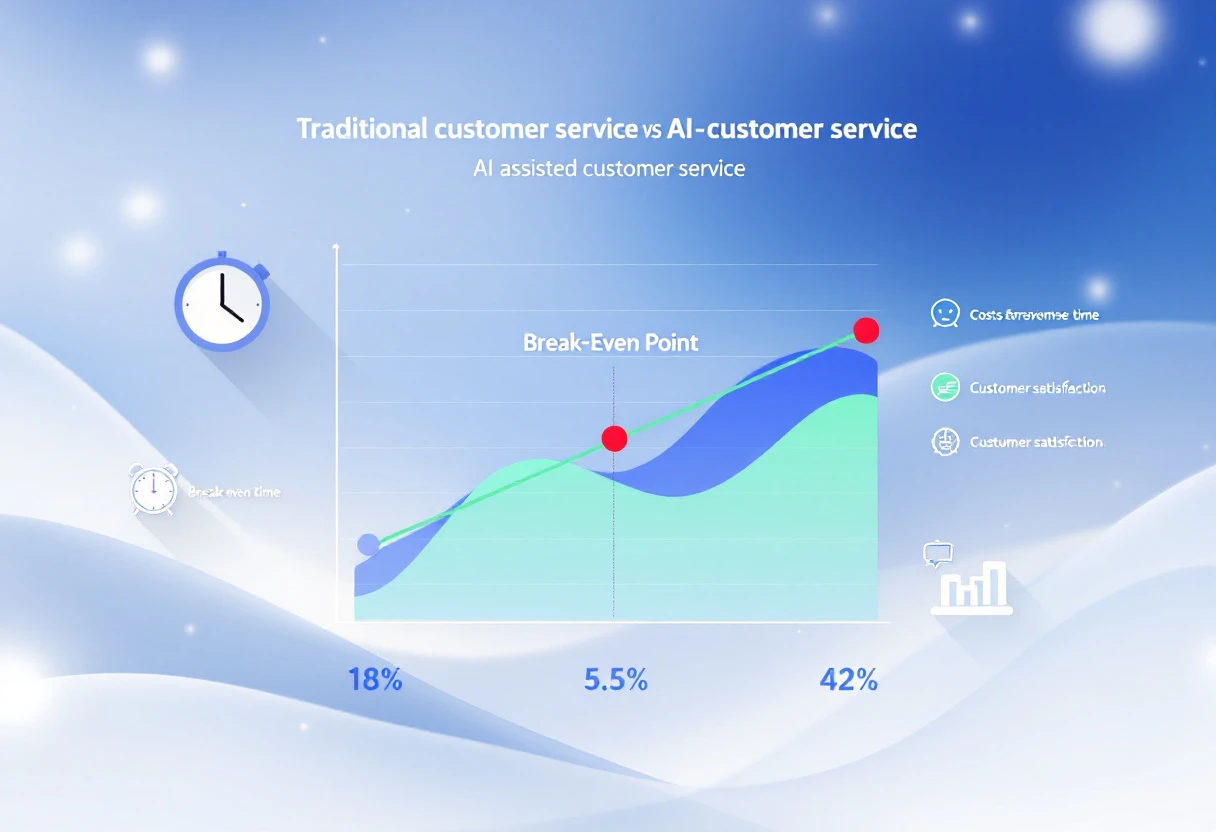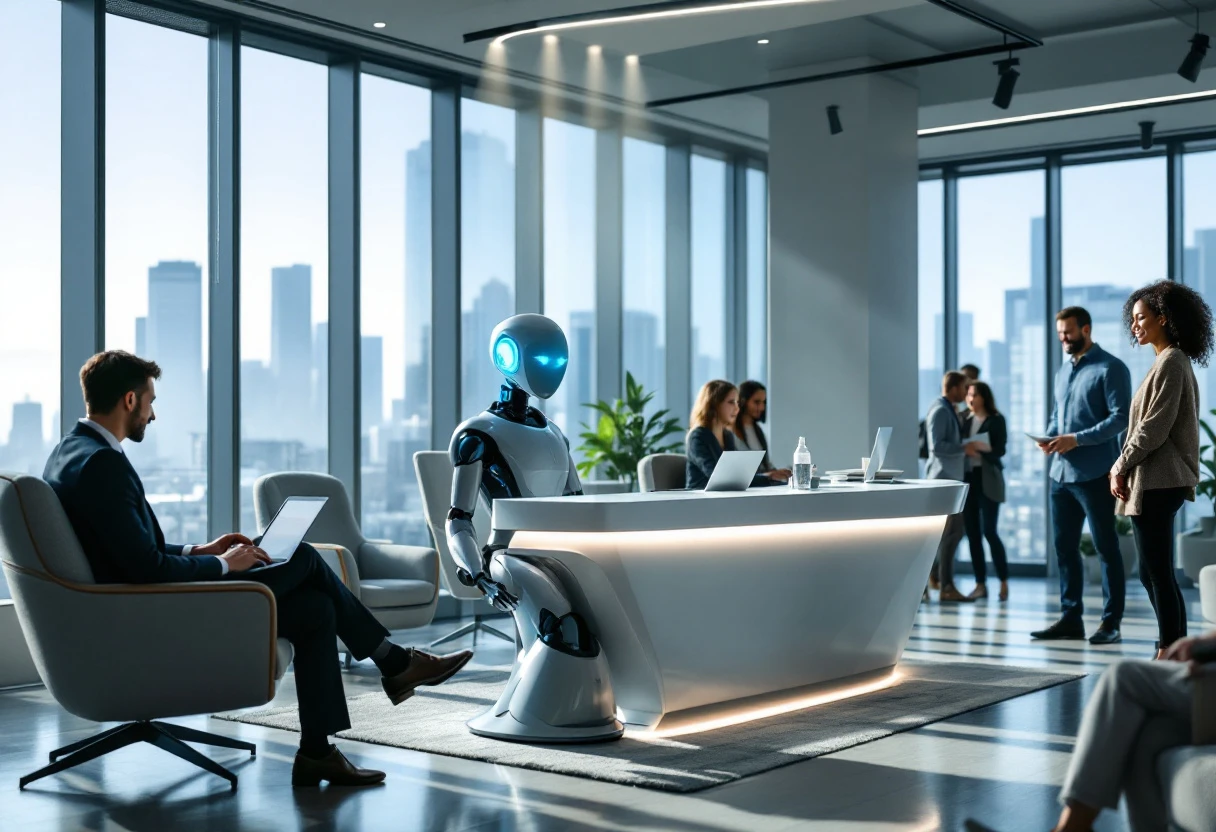
Are you looking to optimize your business operations and achieve profitability faster? Discover how adopting an AI receptionist can transform customer service, drive operational efficiency, and reduce costs. This approach not only streamlines processes but also enhances customer satisfaction, paving the way for quicker break-even points and sustainable growth.
The break-even point is the moment when total revenues equal total costs. Knowing when you reach this point is vital for business owners. It signals the shift from loss to profit. This concept not only influences pricing strategies but also guides decisions on expenses and revenue generation. A business that identifies this point can focus on growing profits instead of merely covering losses.
To calculate the break-even point, you need a straightforward formula:
For instance, if your fixed costs (like rent and salaries) total $10,000, your selling price per unit is $50, and your variable costs per unit are $30, the calculation would be:
This means you would need to sell 500 units to cover all costs and begin making a profit.
Many businesses traditionally rely on human customer service representatives. This method often involves higher labor costs and can affect the break-even point. If a company spends substantial funds on wages, training, and benefits, it needs to generate significantly more revenue to break even. For example, a small business with a customer service team that incurs $5,000 monthly may need to generate an additional $20,000 in revenue to cover those costs.
In contrast, implementing an AI receptionist streamlines these operations. The overhead costs reduce dramatically. An AI system can manage up to 80% of customer inquiries without any downtime. This shift means businesses can potentially cut their customer service costs by as much as 50% while maintaining high service levels. The new break-even point becomes much more achievable.
Statistical Insight: According to a recent industry report, companies using AI solutions in customer service have seen an average of 20% growth in profit margins over three years due to reduced operational costs and improved efficiency.
Let's say you run a store where you integrate an AI receptionist into your workflow. If your previous costs for a human receptionist were $4,000 a month and your sales revenue per customer was $100, with variable costs of $40, the calculations differ significantly:
This adjustment indicates you only need around 17 customers to break even with the AI-assisted service, compared to a much higher number with a human team.
In this way, adopting an AI receptionist can transform how businesses approach their break-even strategies. With reduced overhead costs and heightened efficiency, companies can strike a balance between offering quality service and achieving profitability sooner.
Operational efficiency isn't just about doing things cheaper; it's about being smarter. A transition to AI can also allow for more scalable customer service solutions, enabling businesses to grow without proportionally increasing costs.

Many businesses rely on traditional receptionist services, but they often face significant limitations. High labor costs are a primary concern. Hiring a full-time receptionist involves expenses like salaries, benefits, and workspace. According to estimates, businesses can spend upwards of $50,000 annually for a single receptionist. This expense can be daunting, especially for small businesses that are still trying to break even.
Availability is another challenge. A traditional receptionist can only handle calls during business hours. This limitation can lead to missed opportunities outside of these hours. A study revealed that nearly 30% of businesses lose potential clients simply because they miss incoming calls. Imagine the financial impact of losing leads due to inadequate follow-up. Companies that implement strategies to maximize engagement can often see a marked improvement in customer retention.
Human error can also be a detrimental factor. Simple mistakes like not scheduling a crucial meeting or misrouting a call can have cascading effects on overall efficiency. The costs associated with correcting these errors add up quickly. Simple miscommunications can damage customer relationships and, in turn, hurt a business's reputation.
Consider the case of a small insurance agency struggling to manage customer inquiries. They relied on a traditional receptionist to handle calls, but often found that calls went unanswered. Customers would frequently complain about delayed responses, leading them to seek services elsewhere. This agency ultimately lost over 20% of its clientele in just six months due to inadequate response times.
Another example involves a local real estate firm. They had a receptionist who worked from 9 AM to 5 PM but dealt with potential buyers in different time zones. Many calls were missed simply because the receptionist wasn’t available. In implementing an AI receptionist, the firm saw a 40% increase in lead conversions. Not only was the AI available 24/7, but it also ensured that all inquiries were promptly followed up.
These examples shed light on the critical financial implications of missing calls and failing to follow up promptly. Adopting a more efficient solution can directly correlate with increased revenue and better client relationships. For more insights on this subject, explore business receptionists effectiveness and customer service automation results.
The inefficiencies arising from human-led operations can be astounding. Think about time management. A receptionist’s day can be interrupted by multiple tasks: answering calls, managing schedules, and handling basic inquiries. Each interruption can lead to a significant loss in productivity. An organization could potentially lose up to 40% of its productive time due to these inefficiencies.
Consider implementing a defined process to streamline operations. Below are simple steps businesses can take:
These steps can position a business to respond more effectively to inquiries and concerns without relying solely on human workforce. Establishing these protocols can substantially expedite the path to breaking even. For further details, view optimizing customer inquiries and case studies on AI implementation.
“By embracing AI solutions, businesses can transform their customer service experience and drive operational efficiencies.” - Expert on AI applications
As businesses strive to improve customer experience while minimizing costs, switching to AI technology isn't just an option—it's becoming a necessity. Looking into various customer engagement strategies or AI in customer service may uncover additional benefits your business could leverage.
By effectively addressing the limitations of traditional receptionist services, businesses are better positioned to grow and succeed in their markets.
In a competitive landscape, businesses can't afford to miss a single inquiry from potential customers. This is where an AI receptionist shines with its constant availability. Unlike traditional staff, an AI receptionist works around the clock, ensuring that customer interactions occur without delay. Imagine a customer reaching out at midnight with an urgent question or request; your AI receptionist promptly handles it, responding instantly and improving customer satisfaction in the process.
For instance, consider a boutique hotel that implemented an AI receptionist. Previously, missed late-night calls resulted in lost bookings. By switching to an AI receptionist, the hotel saw a 30% increase in late-night reservations within the first month. The constant availability not only enhances operational efficiency but also contributes to higher revenue, allowing businesses to reach their break even goals faster.
Not all inquiries can be handled immediately, but letting customers sit in silence is not an option. An AI receptionist incorporates intelligent voicemail that not only captures messages but also categorizes them based on urgency and subject matter. This smart prioritization means your team can focus on the most critical tasks first, enhancing both productivity and customer engagement.
For example, an e-commerce store leveraged intelligent voicemail to triage customer complaints and inquiries. As a result, they reported a 40% speed-up in response times because urgent issues were highlighted for immediate action. This shift allowed them to resolve customer concerns quicker and maintain high engagement levels—a win-win situation. With efficient voicemail management, businesses can ensure they never miss important communications.
Automating text workflows can transform how businesses communicate with customers. An AI receptionist can send timely updates, reminders, and even handle FAQs without the need for human intervention. This reduces workload for staff while keeping the lines of communication open. The ability to send personalized texts also creates stronger customer relationships, making clients feel valued and informed.
A local gym that adopted AI text workflows reported a significant decrease in appointment no-shows. By sending automated reminders, the gym realized a remarkable 25% reduction in missed sessions, allowing them to better utilize their resources. Not only does this streamline operations but it also ensures that customers remain engaged and place value on their services.
In a detailed survey, over 70% of users stated they prefer receiving automated reminders for appointments, highlighting the importance of efficient communication in fostering loyalty. By integrating automated text workflows, your business can enhance customer satisfaction and encourage repeat visits, helping you break even more swiftly.

Leveraging an AI receptionist program from AI Front Desk can redefine how businesses interact with customers, streamline operations, and create meaningful relationships. When resellers offer these features, they not only make their offerings more appealing but also stand out in a crowded market. Such technology enhances customer service, drives engagement, and ultimately leads to a faster path to profitability.
When evaluating the cost implications of a human receptionist versus an AI receptionist, the numbers tell a compelling story. A traditional receptionist typically costs between $30,000 to $50,000 annually, factoring in salary, benefits, and potential overtime. In contrast, implementing an AI receptionist can entail initial setup costs but often falls under $1,000 monthly once operational. Over a year, this translates to about $12,000—a significant savings!
Moreover, consider the overhead. Human receptionists typically require a dedicated workspace and resources, such as a computer and phone line. An AI receptionist, like those offered by AI Front Desk, requires minimal physical resources, slashing overhead costs further.
To illustrate, let’s look at a small business employing a human receptionist versus transitioning to an AI system. After a year, if the human receptionist costs $40,000, while the AI solution costs $12,000, the business can save $28,000. These savings can be redirected to marketing or product development, enhancing overall revenue potential. For resellers, documenting these cost savings through case studies can be a powerful tool in client negotiations.
Beyond cost savings, an AI receptionist can significantly enhance customer service, leading to increased sales. A 2023 study indicated that businesses using AI-driven customer interaction platforms see a revenue increase of approximately 15%. This can be attributed to faster response times, reduced wait times, and the ability to handle multiple inquiries simultaneously.
Take the example of a retail store. If a human receptionist manages 10 calls daily, an AI receptionist can easily handle 100 or more. This efficiency translates to higher customer satisfaction rates, as they receive quicker resolutions. Happy customers are more likely to convert into repeat buyers, which can positively impact your bottom line. Improving customer service through AI solutions directly correlates with improved revenue.
To understand how an AI receptionist can help your business break even faster, consider implementing a clear ROI analysis. Start by calculating the total cost of ownership for both options—human and AI. This may include:
Once you have these figures, take the savings from switching to AI and the additional revenue generated, then divide by the initial investment. This will give you a clear picture of how quickly your clients can expect to recoup their investment.
An expert in the field noted,
“Investing in technology that enhances customer experience can pay dividends in both savings and sales.”By providing a calculated approach and sharing data insights, you can instill confidence in clients considering this transformative move.

Integrating an AI receptionist not only leads to significant cost reductions but also enhances overall customer experience, paving the way for increased sales and improved revenue. For businesses looking to boost efficiency, the decision to transition from a human receptionist to an AI solution represents both a strategic and financially sound choice.
One notable instance of effective implementation is at a boutique marketing agency. By integrating an AI receptionist, they achieved a 40% reduction in call-handling times. Prior to adopting this solution, their team spent hours managing routine queries, which distracted them from core creative tasks. Post-implementation, they reported that the AI receptionist efficiently managed inquiries such as scheduling and basic customer information.
This shift allowed employees to focus more on project work, ultimately boosting their productivity by 35%. Their ability to redirect efforts led to a noticeable enhancement in client engagement, showcased through improved customer satisfaction ratings. With metrics displaying satisfaction soaring from 82% to 95%, it’s clear that a responsive AI system not only handled the volume but did so with remarkable efficacy.
Another compelling case comes from a tech startup that implemented an AI receptionist during a critical growth phase. The startup saw a spike in customer inquiries as new products launched. Instead of struggling with an overwhelmed team, the business adopted AI technology to enhance their services.
Within three months, they achieved a break-even point 30% faster compared to their previous quarter. The immediate feedback from customers highlighted their appreciation for faster responses. In fact, customer feedback indicated that 90% felt more valued due to timely interactions. As the CEO noted,
“Integrating the AI receptionist was a game-changer; it allowed us to scale without sacrificing service quality.”
This aligns with studies showing that businesses leveraging AI for customer service can enhance efficiency while maintaining a personalized touch. As customer expectations rise, solutions like automated AI outbound phone calls can create seamless experiences.
When discussing the metrics of success, one promising statistic emerged: companies employing AI receptionists have reported a 25% increase in overall operational efficiency. For instance, a well-known salon chain adopted this technology, witnessing not only faster service but also higher client retention rates. Their data indicated that clients were booking appointments with 50% less waiting time.
This compounded customer loyalty contributed to reduced operational costs and an overall enhanced bottom line. In addition, another company employed best practices in AI implementation, and within six months logged customer interactions that saved approximately 20 hours per week across their staff.
Ultimately, success stories like these underscore the viability of AI solutions in everyday business scenarios, validating the phrase: an AI receptionist can help businesses break even faster. As more entrepreneurs recognize the efficiencies afforded by these systems, the trend towards adoption will likely continue to grow.
Transitioning to an AI receptionist is more straightforward than many think. Initially, you’ll want to explore AI receptionist solutions to identify the features that best suit your business. Visit the AI Front Desk website where you can sign up for the AI Front Desk program. This process is user-friendly, typically involving a few basic steps:
As an example, a small tech startup switched to an AI receptionist after struggling with high overhead costs. By adopting an AI receptionist, they managed to reduce costs by 30% within the first quarter, evidencing how adopting new technology can significantly impact your break-even point.
After signing up, the next crucial step is customizing your AI receptionist. Define your business requirements and create a clear vision of how you want it to operate. Consider key factors like:
According to recent data, companies that implement customer service automation report a 15% increase in customer satisfaction. Therefore, customizing your AI receptionist not only streamlines processes but can also enhance customer interaction significantly.
Transitioning from a traditional receptionist to an AI solution can be challenging, but with careful planning, you can ensure a smooth conversion. Here are some effective strategies:
As a final note, one expert succinctly put it: “Automation shouldn't replace human interaction; it should enhance it.” This highlights the importance of balancing technology with personal touch, which can yield a smoother transition and enhance overall customer satisfaction.

In a world where customer expectations continue to rise, businesses face the challenge of maintaining strong relationships without stretching their resources too thin. An AI receptionist effectively meets this challenge by providing immediate responses and support to customer inquiries. This level of engagement not only enhances the customer experience, but it also contributes to the bottom line.
For example, a small retail business integrating an AI receptionist reported a 30% increase in customer satisfaction ratings. Their customers appreciated instant responses to common questions about product availability, store hours, and promotional deals. By improving engagement, the business saw a rise in foot traffic and, ultimately, sales.
Using an AI receptionist allows businesses to respond to customer inquiries 24/7, freeing up human staff for more complex tasks. This level of responsiveness is essential in today’s market. A survey indicated that 75% of customers prefer businesses that provide fast, reliable responses. Implementing AI solutions for reception duties can streamline the way businesses interact with their clients, paving the way for improved customer loyalty.
Operational efficiency is crucial for any business aiming to break even faster. The traditional receptionist model often falls short due to limitations in scale and availability. In contrast, an AI receptionist automates routine tasks such as appointment scheduling, FAQs, and call filtering, significantly boosting productivity.
Consider a dental clinic that deployed an AI receptionist to manage appointments and patient inquiries. In just three months, they reported a 40% decrease in appointment no-shows and a 50% reduction in calls waiting time. This efficiency not only freed up staff but also allowed the clinic to serve more patients, directly impacting profitability.
With less time spent on administrative tasks, employees can focus on higher-value work, such as building relationships with customers. As a result, operations improve significantly—both in terms of service quality and employee satisfaction. Streamlining workflows through AI enhances the working environment while optimizing the overall customer experience.
Every business seeks to minimize costs while maximizing revenue. An AI receptionist can play a pivotal role in this mixture. By reducing overhead costs through automation, businesses can direct resources toward growth initiatives, thereby shortening the time to .break even.
Research has shown that companies implementing AI technologies experience revenue increases of up to 20% within a year. The faster an organization can respond to inquiries and optimize its processes, the quicker it can achieve financial sustainability. Furthermore, a clear advantage lies in the scalability of AI solutions. As a business grows, an AI receptionist can adapt without the need for additional hiring, thus controlling labor costs.
Whether it’s through decreasing customer wait times or increasing the volume of handled queries, it’s evident that an AI receptionist significantly contributes to operational success. For information on deployment and best practices, you can explore implementation guides that explore how to optimize your workforce.
Considering the multitude of advantages from customer engagement to operational efficiency, businesses should take a closer look at how an AI Front Desk solution could revolutionize their service experience and drive profitability.
An AI receptionist is a software solution that handles customer inquiries and tasks typically managed by human receptionists. It can respond to calls, emails, and messages 24/7, improving service quality and efficiency.
An AI receptionist streamlines customer interactions, reduces operational costs, and enhances availability. This allows businesses to serve customers faster and more effectively, leading to improved satisfaction and potential increases in revenue.
Using an AI receptionist can significantly lower staffing costs. While a human receptionist may cost $30,000 to $50,000 annually, an AI solution can be around $12,000 per year, offering substantial savings for businesses.
The break-even point can be calculated using the formula: Break-Even Point (BEP) = Fixed Costs / (Selling Price per Unit - Variable Costs per Unit). This tells you how many units you need to sell to cover costs.
Yes, an AI receptionist can increase customer satisfaction by providing quick responses, reducing wait times, and being available 24/7, which meets modern customer expectations.
To implement an AI receptionist, you can research available solutions, sign up for a service, customize it to fit your needs, and ensure proper training for your team on how to use it effectively.
Any business that deals with customer inquiries can benefit from an AI receptionist, including retail stores, medical offices, real estate firms, and service-based industries, among others.
Start your free trial for My AI Front Desk today, it takes minutes to setup!






